簡介:弗里達·卡羅及其超現實主義現代藝術的不朽遺產
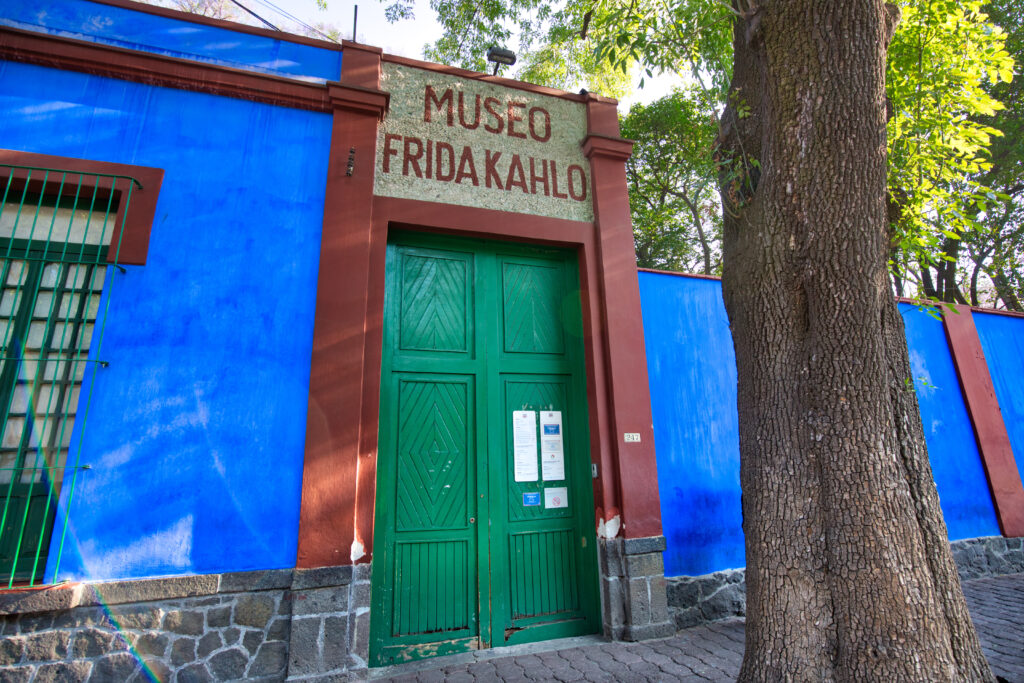
弗里達·卡羅(Frida Kahlo)超現實主義藝術是現代藝術中最知名和最有影響力的人物之一 繪畫,不僅因為她作品的視覺美感,還因為她所描繪的情感深度和原始脆弱性。卡羅於 1907 年出生於墨西哥科約阿坎,她的人生旅程充滿了強烈的身體和情感痛苦,她將這些痛苦轉化為引起全球觀眾深刻共鳴的傑作。她的作品以鮮豔的色彩、大膽的象徵主義以及墨西哥傳統與超現實主義影響的融合為特點,鞏固了她在藝術界的地位。 的世界 文化藝術 以及更遠的地方。
從她探索身份、痛苦和 自我反省 憑藉其涉及墨西哥文化和女性主義意識形態的深刻政治作品,弗里達·卡羅成為藝術和激進主義的開拓者。作為女權主義偶像,她挑戰社會規範。她用她的工作 去探索她 藝術表達, 聚焦 關於性別、種族和階級等主題,這些主題在今天仍然和她那個時代一樣重要。
卡羅的影響力遠遠超出了傳統的界限 繪畫。她獨特的風格,通常被歸類為超現實主義,深深植根於她的現實而不是夢想,使她的藝術超越了流派。弗里達成為邊緣群體的代言人,從婦女和原住民到那些與慢性病奮鬥的人,就像她一樣。卡羅對苦難和韌性的毫無歉意的描繪,加上她作為雙性戀女性的複雜身份,使她不僅是一位藝術家,而且是耐力、叛逆和力量的象徵。
在這篇文章中,我們將探討弗里達·卡羅的生活和奮鬥,深入探討塑造她藝術演變的關鍵時刻以及她留下的不朽遺產。我們將追溯她的早年生活,以疾病和改變生活的事故為標誌,這些事故使她走上了一條新的藝術道路,以及她與同行藝術家迭戈·裡維拉的混亂關係。我們也將看看她的作品,曾經主要被主流藝術評論家駁斥,如何定義現代 文化藝術 以及為什麼她 藝術表現 在21世紀繼續引起共鳴。
當我們回顧卡羅的生活和藝術時,我們將探討她的影響如何持續存在於當代藝術中,激發挑戰規範和頌揚個性的運動。她的遺產在畫廊、博物館和 線上藝術 社區、 鼓舞人心的 一代又一代的藝術家、活動家和崇拜者。弗里達·卡羅 (Frida Kahlo) 以其獨特的風格和大膽的精神,留下了一系列不僅打破了傳統規則的作品 繪畫 但也為更包容和情感上誠實的未來鋪平了道路 藝術表現.
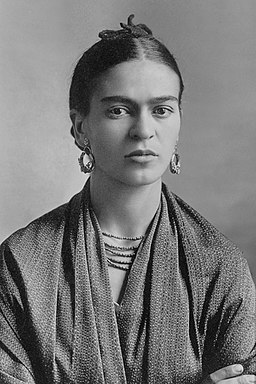
弗里達卡羅 (Frida Kahlo) 是現代藝術界最知名、最具影響力的人物之一 繪畫,不僅因為她作品的視覺美感,還因為她所描繪的情感深度和原始脆弱性。卡羅於 1907 年出生於墨西哥科約阿坎,她的人生旅程充滿了強烈的身體和情感痛苦,她將這些痛苦轉化為引起全球觀眾深刻共鳴的傑作。她的作品以鮮豔的色彩、大膽的象徵主義以及墨西哥傳統與超現實主義影響的融合為特點,鞏固了她在藝術界的地位。 的世界 文化藝術 以及更遠的地方。
從她探索身份、痛苦和 自我反省 憑藉其涉及墨西哥文化和女性主義意識形態的深刻政治作品,弗里達·卡羅成為藝術和激進主義的開拓者。作為女權主義偶像,她挑戰社會規範。她用她的工作 去探索她 藝術表達, 聚焦 關於性別、種族和階級等主題,這些主題在今天仍然和她那個時代一樣重要。
卡羅的影響力遠遠超出了傳統的界限 繪畫。她獨特的風格,通常被歸類為超現實主義,深深植根於她的現實而不是夢想,使她的藝術超越了流派。弗里達成為邊緣群體的代言人,從婦女和原住民到那些與慢性病奮鬥的人,就像她一樣。卡羅對苦難和韌性的毫無歉意的描繪,加上她作為雙性戀女性的複雜身份,使她不僅是一位藝術家,而且是耐力、叛逆和力量的象徵。
在這篇文章中,我們將探討弗里達·卡羅的生活和奮鬥,深入探討塑造她藝術演變的關鍵時刻以及她留下的不朽遺產。我們將追溯她的早年生活,以疾病和改變生活的事故為標誌,這些事故使她走上了一條新的藝術道路,以及她與同行藝術家迭戈·裡維拉的混亂關係。我們也將看看她的作品,曾經主要被主流藝術評論家駁斥,如何定義現代 文化藝術 以及為什麼她 藝術表現 在21世紀繼續引起共鳴。
當我們回顧卡羅的生活和藝術時,我們將探討她的影響如何持續存在於當代藝術中,激發挑戰規範和頌揚個性的運動。她的遺產在畫廊、博物館和 線上藝術 社區、 鼓舞人心的 一代又一代的藝術家、活動家和崇拜者。弗里達·卡羅 (Frida Kahlo) 以其獨特的風格和大膽的精神,留下了一系列不僅打破了傳統規則的作品 繪畫 但也為更包容和情感上誠實的未來鋪平了道路 藝術表現.
二.墨西哥科約阿坎的早年生活
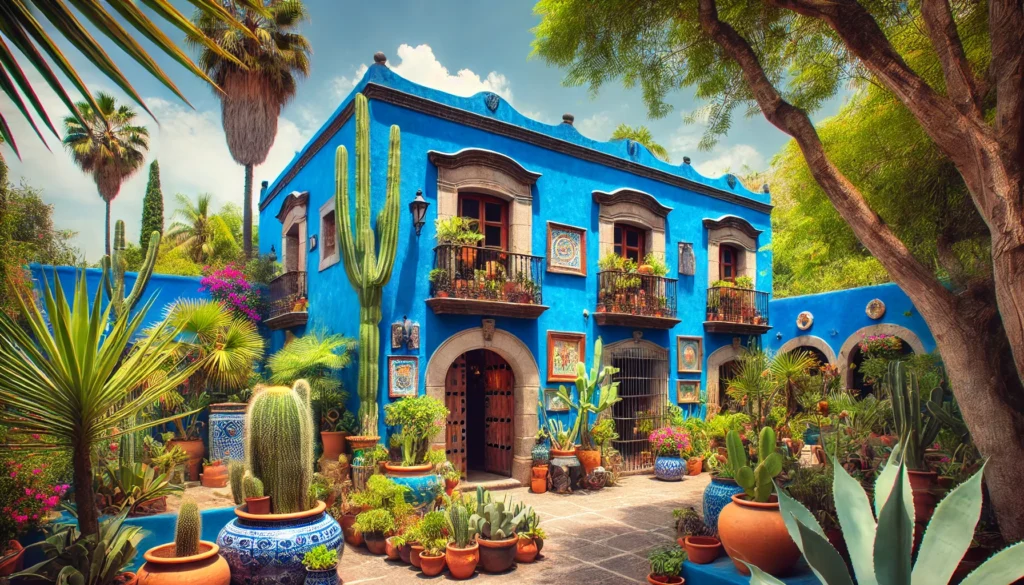
弗里達·卡羅 (Frida Kahlo) 在墨西哥科約阿坎 (Coyoacán) 的早年生活充滿了豐富的文化、家庭的影響和早期的奮鬥,這些都塑造了她日後成為的藝術家。卡羅出生於1907 年7 月6 日,原名瑪格達萊娜·卡門·弗里達·卡洛·卡爾德龍(Magdalena Carmen Frida Kahlo y Calderón),她的一生始於La Casa Azul(又稱「藍屋」),這棟建築後來成為一座著名的博物館,以紀念她的遺產。她在科約阿坎(Coyoacán)長大,這個小鎮後來成為繁華的墨西哥城的一部分,她被傳統的墨西哥文化和生動的意象所包圍,這些後來成為她不可或缺的一部分 繪畫。她的早期經歷為她一生的藝術之旅、她對藝術的探索奠定了基礎。 文化藝術,以及她深刻的認同感和目標感。
弗里達·卡羅的出生與家庭背景
弗里達出生在一個混血家庭,這極大地影響了她對世界的獨特看法。她的父親吉列爾莫·卡洛 (Guillermo Kahlo) 是一位移居墨西哥的德國攝影師,將 歐洲的影響將補充弗里達母親瑪蒂爾德·卡爾德隆·岡薩雷斯的墨西哥傳統。瑪蒂爾德是一個 混血兒 西班牙和土著血統,一個譜系 後來弗里達透過探索身份、種族和遺產等主題,激發了她的工作靈感 藝術表現。歐洲和原住民文化的融合在弗里達的人生觀中發揮了至關重要的作用,幫助 塑造她原創藝術作品的深刻個人性和象徵性本質.
吉列爾莫·卡羅(Guillermo Kahlo)是弗里達一生中的重要人物。作為一名攝影師,他向她介紹了視覺藝術 早期的,讓她接觸到構圖、透視和燈光等技術方面的知識。芙烈達經常陪伴 她的父親捕捉了墨西哥的建築之美和風景,這加深了她與墨西哥文化和藝術遺產的聯繫。從很多方面來說,吉列爾莫的攝影激發了弗里達一生對自畫像的迷戀,她後來創作了自己的自畫像。 視覺敘事透過 繪畫,常以她自己為中心物。他們的聯繫超越了藝術影響;吉列爾莫 在弗里達童年患病期間為她提供支持,培養了她的韌性,這成為她性格的標誌。
堅韌的童年
弗里達的童年一點也不輕鬆。六歲時,她感染了小兒麻痺症,這種疾病使她臥床數月,並導致她的右腿永久性跛行。她從小就承受的身體限制灌輸了她深刻的決心和獨立感,定義了她 她作為藝術家和個人的晚年。在此期間,她的父親成為她最親密的盟友,鼓勵她保持堅強,並透過運動和遊戲幫助她恢復活動能力。
儘管患病,弗里達仍決心過著積極的生活。她拒絕讓自己的病情限制她,並在 十幾歲的時候,她開始參加拳擊、游泳和其他通常只有男孩才能參加的體育活動。這些童年軼事讓我們得以一窺後來定義弗里達藝術認同的熾熱精神。即使作為一個年輕女孩,她就已經在挑戰社會規範和期望,這後來在她身上體現出來 創意表達 她用自己的工作來面對性別、殘疾和身分認同問題。
墨西哥文化對她早期藝術的影響
弗里達·卡羅周圍的世界充滿了墨西哥文化的鮮豔色彩、傳統和儀式。墨西哥革命始於 1910 年弗里達三歲的時候,深刻地影響了國家的文化景觀。在革命後的時期,人們重新燃起了對 文化藝術,特別是在恢復墨西哥本土認同和拒絕歐洲殖民影響方面。隨著弗里達長大,這種文化復興將 深刻地 影響她 工作,引導她注入她 繪畫 具有傳統的墨西哥符號、顏色和主題。
卡羅與墨西哥文化的連結也體現在她對原住民藝術和民間傳說的迷戀上。她的母親瑪蒂爾德在傳承這些傳統方面發揮了重要作用,讓弗里達接觸到墨西哥原住民充滿活力的文化遺產。從很小的時候起,弗里達就對墨西哥工藝品、宗教圖像和自然的象徵性運用著迷。這些元素後來成為她不可或缺的一部分 藝術表現,特別是在她的原創藝術作品中對植物、動物和宗教符號的使用。弗里達與她的墨西哥血統的深厚聯繫使她有別於同時代的其他藝術家,使她在藝術領域擁有獨特的聲音。 文化藝術.
早期對醫學的興趣
在弗里達·卡羅考慮成為一名藝術家之前,她曾夢想成為一名醫生。她早年對科學和醫學的迷戀促使她進入墨西哥城國家預科學校就讀,她是這所著名學府僅有的 35 名女孩之一。在學校裡,弗里達在生物學和解剖學方面表現出色,她渴望了解人體,而人體已經成為痛苦和限制的根源 由於她自幼患病。
這種早期對醫學的興趣後來與她的藝術相交,特別是在戲劇性地改變了她的生活的公共汽車事故之後。她所學到的醫學知識 在國立預科學校的學習將幫助她在繪畫中以無與倫比的細節和情感深度來描繪人體。她對解剖學的興趣,加上她個人的痛苦經歷,給了她獨特的視角,這也奠定了她後來的地位。 藝術表現 在《斷柱》等作品中,她生動地描繪了自己身體上的痛苦。
雖然弗里達最終放棄了成為醫生的夢想,但她對醫學的熱情從未消失。這成了她反覆出現的主題 绘画,因為她利用自己對人體的了解,創作了對疼痛、疾病和康復的令人難忘的、發自內心的描述。這種個人與科學的融合使弗里達的作品如此強大;她的畫作是視覺表現和情感風景,探索身心、痛苦和療癒之間的複雜關係。
墨西哥政治文化對弗里達早期發展的影響
弗里達·卡羅 (Frida Kahlo) 的青春期恰逢 墨西哥劇烈的政治變革。墨西哥革命的餘波帶來了民族自豪感的高漲和對重建統一文化認同的關注。這個時代被稱為墨西哥文藝復興,見證了墨西哥的復興 文化藝術,與藝術家、知識分子和政治家 尋求頌揚墨西哥的土著遺產並抵制歐洲殖民影響。
這種文化轉變深刻地影響了弗里達作為個人和藝術家的早期發展。她對當時政治和社會運動的接觸使她產生了強烈的民族自豪感,並渴望為墨西哥的文化復興做出貢獻。在國家預科學校,她結識了一群政治活躍的學生洛斯·卡丘查斯(Los Cachuchas),他們與她有著相同的左翼理想和對墨西哥身份的熱情。透過這個團體,弗里達第一次見到了著名的壁畫家迭戈·裡維拉(Diego Rivera),他後來成為她的丈夫,並對她的生活和事業產生了深遠的影響。
即使在早年,弗里達的藝術也反映了她與墨西哥政治和文化的深刻聯繫。她經常將土著符號和圖像融入她的作品中,並使用 藝術表現 探索身份、革命和社會正義等主題。隨著年齡的增長,她的政治信念在她的藝術中變得更加突出。儘管如此, 她的革命精神的種子是在革命後的墨西哥的成長歲月中播下的。
早期藝術實驗與靈感
儘管弗里達·卡羅 (Frida Kahlo) 最出名的是她 绘画,她早期的藝術實驗 多種多樣。 在 在國立預科學校,她第一次被介紹到 組合藝術 透過她與鼓勵她探索不同媒介的同學的友誼。她涉足從繪畫到攝影的各個領域。儘管如此,直到事故發生後的晚年,她才開始認真對待自己的繪畫。
然而,在早年,弗里達深受迭戈·裡維拉的作品啟發,她欽佩他的大型壁畫以及他對墨西哥社會和政治事業的承諾。裡維拉在作品中專注於表現墨西哥人民的鬥爭,這對弗里達的藝術態度產生了持久的影響。雖然她早期的實驗很大程度上是非正式的和探索性的,但它們為 發展 她獨特的風格,後來將個人與現實融為一體 政治的 以及傳統與現代。
弗里達早期的藝術影響還包括墨西哥民間藝術、宗教圖像和原住民工藝傳統,所有這些都將成為她後來作品的顯著特徵。即使作為一名年輕藝術家,她就已經開始嘗試以自己獨特的方式將這些元素結合在一起。這種無所畏懼的做法 藝術表現 最終使弗里達·卡羅成為 20 世紀最著名和最有影響力的藝術家之一。
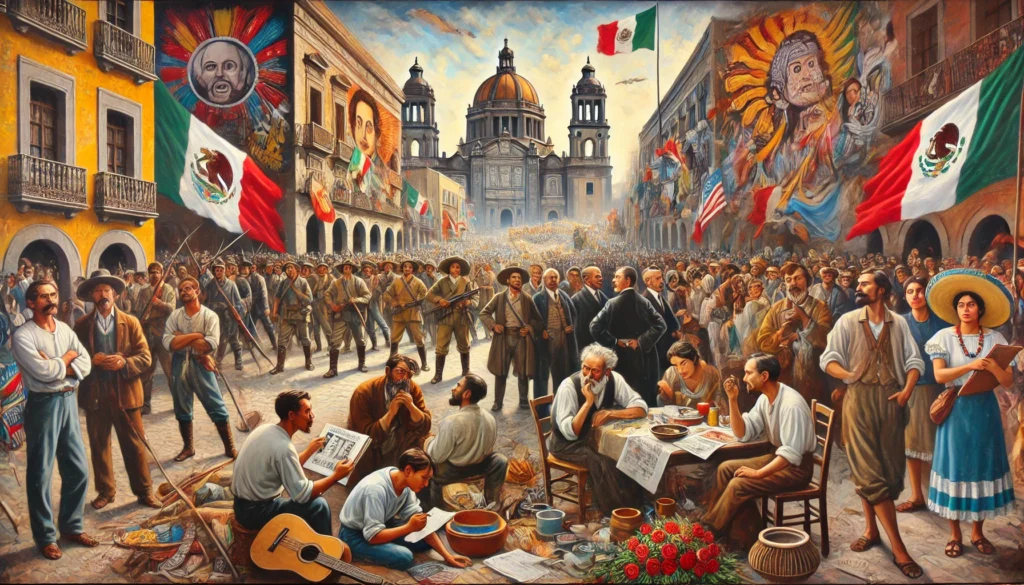
三.改變生活的事故
1925 年巴士事故:弗里達卡羅一生的決定性時刻
1925 年 9 月,18 歲的弗里達·卡羅 (Frida Kahlo) 的生活發生了永遠的改變。她和男友亞歷杭德羅·戈麥斯·阿里亞斯 (Alejandro Gómez Arias) 放學回家。Youtube 視頻),當他們乘坐的木製巴士與有軌電車相撞時。其影響是毀滅性的。幾名乘客喪生,弗里達是受傷最嚴重的倖存者之一。一根金屬扶手刺穿了她的腹部,導致她的脊椎、骨盆、鎖骨和肋骨骨折。她的右腿多處骨折,腳也被壓碎。這次事故標誌著弗里達一生痛苦和醫療併發症的開始,她臥床數月,一生接受了 30 多次手術。
身體上的創傷是巨大的,但情感上的損失同樣嚴重。在事故發生後的幾天裡,醫生不確定弗里達是否能活下來。她的父母,尤其是她的父親吉列爾莫,在康復的最初階段支持她,但未來的漫長道路似乎充滿不確定性。弗里達全身打著石膏,忍受了幾個月的痛苦,一動也不動,與她曾經熟悉的生活隔絕。她生命中的這段時期的特點是身體疼痛與充分生活的願望之間不斷的鬥爭,這成為她反覆出現的主題。 繪畫 和藝術視野。
醫療和復健的代價
弗里達從事故中恢復過來是漫長而艱難的。最初,她接受了一系列痛苦的醫療程序來治療她的傷勢,包括脊椎調整和使用身體石膏來穩定骨折的骨頭。弗里達被困在床上,經歷了巨大的身體痛苦,而突然與世隔絕的情緒壓力又加劇了這種痛苦。這位曾經活躍、立志成為醫生的年輕女子現在臥床不起,無法追求自己規劃的生活。
這次事故也為她帶來了持久的健康問題,包括慢性疼痛、脊椎損傷和生殖系統併發症,這些問題後來導致了幾次流產。儘管經歷了痛苦,這段恢復期也成為弗里達卡羅藝術成型的嚴酷考驗。無法自由行動的她開始將挫折、痛苦和自我探索傾注在自己身上 原創藝術品,標誌著她作為畫家的旅程的開始。
弗里達的母親瑪蒂爾德在她的床邊安裝了一個特殊的畫架,讓她可以躺著畫畫。她的父親給了她顏料和畫筆,鼓勵她用藝術作為治療。弗里達在這段時間凝視著床上方的鏡子畫了她的第一幅自畫像。這些自畫像將成為她的基礎 表現藝術,其中她探討了身份、痛苦和自我反思的主題。
繪畫作為治療:激情的誕生
在漫長的康復過程中,弗里達開始以新的目標感進行繪畫。曾經的愛好變成了生命線,一種處理創傷和表達內心想法的方式。她的第一幅自畫像,如《穿著天鵝絨連身裙的自畫像》(1926),展示了一位年輕女子與身體和情感上的痛苦作鬥爭,但仍然散發著力量和反抗感。這些早期作品將個人經驗與強大的視覺象徵主義融為一體,為弗里達獨特的表現藝術風格奠定了基礎。
弗里達的早期繪畫深受她所欣賞的古典歐洲風格的影響,包括文藝復興時期的肖像畫。然而,她的作品很快就開始呈現出更個人化和象徵性的基調,反映了她對生活、痛苦和人類經驗的獨特視角。她曾經說過:“我畫自己是因為我經常獨自一人,因為我是我最了解的主題。”她的自畫像成為一種自我探索和自我表現的形式,讓她在面對壓倒性的身體限制時重新找回自己的身份。
正如她的熱情 繪畫 隨著年齡的增長,弗里達從將藝術視為一種治療方法轉變為認識到它是她人生的使命。隨著時間的推移,她的作品逐漸融入了以下元素: 抽象藝術、超現實主義和墨西哥民間傳統,使她成為20世紀藝術中最獨特的聲音之一。
超現實主義的影響與自我反思
儘管弗里達·卡羅經常與超現實主義運動聯繫在一起,但她拒絕接受這個標籤是眾所周知的。 「我從來沒有畫過夢,」她曾經說過。 “我描繪了我的現實。”儘管如此,她的作品與超現實主義有許多相似之處,特別是對奇幻意象、鮮豔色彩和夢幻構圖的運用。她的畫作經常模糊現實與想像之間的界限,將個人經驗與神話和象徵元素融為一體。
卡羅藝術的關鍵方面之一是她透過象徵意象描繪複雜的情感和心理狀態的能力。在《斷柱》(1944)等作品中,她透過石頭製成的折斷脊椎描繪自己,周圍是貧瘠的風景,來表現身體上的痛苦。在另一幅畫《亨利·福特醫院》(1932)中,她透過將自己的身體與胎兒、蘭花和蝸牛等超現實的象徵性元素並置來傳達流產的創傷。這些作品體現了她將個人痛苦轉化為深刻的藝術表達的能力。
卡羅的使用 抽象藝術 讓她能夠探索傳統現實主義無法傳達的深刻情感真理。她的作品經常挑戰分類,融合超現實主義、墨西哥民間藝術和個人像徵主義來創造她的視覺語言。這種獨特的方法使她有別於同時代的其他藝術家,使她成為藝術世界的開拓者。 原創藝術品 和 表現藝術.
四.與迭戈·裡維拉的關係
遇見迭戈·裡維拉:弗里達生活與藝術的轉捩點
1929 年,就在事故發生幾年後,弗里達·卡羅(Frida Kahlo) 遇到了迭戈·裡維拉(Diego Rivera),後者是墨西哥藝術界的傑出人物,也是壁畫運動的領導者。裡維拉已經是一位知名藝術家,以其描繪墨西哥工人階級鬥爭的大型壁畫而聞名。當弗里達第一次接近他時,她尋求他對她的工作的意見,希望得到她深深敬佩的人的認可。裡維拉被她的才華和獨特的眼光所吸引,鼓勵她繼續繪畫,並對她的作品表示欽佩。
兩人很快就建立了戀愛關係,儘管年齡差距很大——裡維拉比卡羅大 21 歲——但他們還是在 1929 年結婚。兩人都非常獨立且充滿激情,他們的關係充滿了愛、不忠和相互欽佩。對弗里達來說,迭戈不僅成為了情人和伴侶,也成為了靈感的來源。他對她能力的信心讓她有勇氣接受自己作為藝術家的身份並追求她 繪畫 帶著新的決心。
迭戈·裡維拉政治活動的影響
迭戈·裡維拉不僅是一位藝術家,也是一位堅定的政治活動家。他參與墨西哥共產黨以及與托洛斯基等革命領袖的密切關係影響了弗里達的政治信仰,並最終影響了她的藝術。裡維拉的壁畫經常描繪工人階級的鬥爭,他對社會正義的承諾與弗里達產生了深刻的共鳴。受到迭戈榜樣的啟發,她開始將政治訊息融入她的藝術中,創作出解決階級、種族和性別問題的作品。
弗里達的政治活動也超出了她的藝術範圍。她加入了共產黨,並成為工人權利、原住民權利和女權主義事業的直言不諱的倡導者。她 社會評論藝術 反映了這些信念,經常描繪墨西哥和世界各地邊緣群體所面臨的不公現象。對弗里達來說,藝術是自我表達的手段和政治變革的工具。
他們關係中的挑戰:愛情、不忠與藝術
弗里達和迭戈的關係既動盪又充滿激情。兩人都以火爆的脾氣和複雜的愛情生活而聞名。雖然他們彼此深愛和欽佩,但他們的婚姻卻因雙方的不忠而受到困擾。迭戈的眾多風流韻事,包括與弗里達的妹妹克里斯蒂娜的風流韻事,給他們的關係造成了巨大的壓力。弗里達也有婚外情,包括與男女的浪漫糾葛。
儘管面臨這些挑戰,這對夫婦仍然彼此忠誠。他們於 1939 年分居,一年後再婚。弗里達在他們的關係中將她的情感痛苦轉化為她的藝術,在最非同尋常的動盪期間創作了一些最著名和深刻的個人作品。其中一幅作品是《兩個弗里達》(1939),它描繪了藝術家並排坐著、手牽手的兩個版本。弗里達穿著一件傳統的特瓦納服裝,代表了她的墨西哥身份。相較之下,另一位則穿著歐式連身裙,象徵著她與裡維拉分離期間所承受的情感痛苦。這幅畫體現了她將自己的掙扎轉化為現實的能力 原創藝術品.
對弗里達來說,她與迭戈關係的痛苦與她的工作密不可分。它是其中不可分割的一部分。她 表現藝術 她的畫作經常反映他們婚姻中情感的高潮和低谷,使她的畫作成為現代歷史上最親密、最具啟發性的藝術作品。
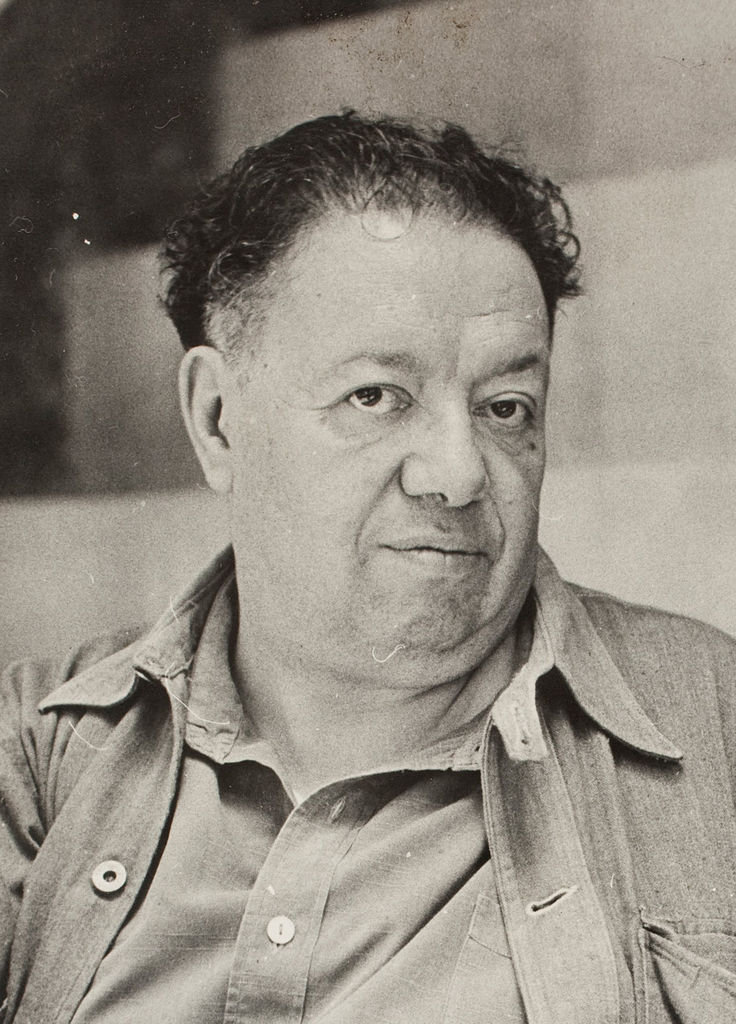
迭戈·裡維拉1886年12月8日出生於墨西哥瓜納華托,成為20世紀最具影響力的藝術家之一。
年僅十歲,他就開始在墨西哥城的聖卡洛斯學院學習藝術。裡維拉在西班牙和法國學習期間早期接觸歐洲藝術運動,大大塑造了他的風格,融合了立體主義、後印象派和墨西哥民間傳統。
到 1920 年代,裡維拉回到墨西哥,在那裡他完全接受了壁畫主義。他對使用藝術作為教育和社會變革工具的信念堅定不移,他創作了描繪墨西哥歷史和文化及其人民鬥爭的大型壁畫。這些壁畫經常展現革命、工業化和工人權利等主題,成為墨西哥社會的強大聲音。裡維拉對色彩和紀念性人物的生動運用,受到前哥倫布時期藝術和義大利文藝復興時期壁畫技術的啟發,捕捉了墨西哥後革命時代的精神。
裡維拉的職業生涯延伸到了墨西哥以外的地區。他在美國繪製壁畫,包括底特律藝術學院的著名作品和備受爭議的紐約洛克菲勒中心壁畫,該壁畫因描繪列寧而被摧毀。他直言不諱的共產主義信仰和個人生活,包括他與藝術家弗里達·卡羅的混亂婚姻,也引起了廣泛的關注。
迪亞哥·裡維拉在現代藝術中留下了不可磨滅的印記,將政治、歷史和原住民文化融入強大的公共藝術作品中。他的遺產證明了他對社會變革的承諾,在他於 1957 年 11 月 24 日去世很久之後,仍然激勵著全世界一代又一代的藝術家和活動家。
五、藝術演變與突破
弗里達·卡羅的藝術之旅不斷發展,個人探索和突破使她成為國際關注的焦點。她的作品與她的身份深深地交織在一起,一開始是親密的自畫像,但後來成為對國家認同、性別和痛苦等更廣泛的社會問題的有力陳述。隨著時間的推移,Kahlo 獨特的融合 文化藝術、 個人像徵主義和超現實主義元素使她走在現代藝術的最前沿 藝術表現,使她成為邊緣化和受壓迫者的代言人。透過 探索 自我認同、墨西哥本土主題和創新的藝術方法,卡羅成為 20 世紀的開拓者 繪畫.
藝術中自我認同的探索
弗里達·卡羅的作品與她自己的人生故事密不可分。從她最早的繪畫開始,她就以藝術為媒介來探索和傳達她的身份。這種對自畫像的關注,加上她所承受的身體和情感上的痛苦,創造了一系列深刻反思的作品,超越了肖像畫的類型,講述了痛苦、堅韌和身份的普遍主題。
卡羅的自畫像,例如 《戴荊棘項鍊與蜂鳥的自畫像》 (1940)是她最具代表性的作品之一。在這幅畫中,弗里達展示了自己的脖子,荊棘項鍊刺進了她的脖子,流血了。項鍊上懸掛著一隻蜂鳥,肩上則潛伏著一隻黑貓。這幅畫充滿了象徵意義:荊棘代表基督受難的王冠,而像徵愛的蜂鳥卻顯得毫無生氣。她平靜的表情與周圍的暴力之間的對比喚起了堅忍忍耐的主題,這也是她生活的反映。
另一個關鍵工作是 《兩個弗里達》 (1939),描繪了兩個並排坐著的版本的藝術家。其中弗里達身穿歐式白色連身裙,心臟裸露在外,正在流血。同時,另一位弗里達穿著傳統的特瓦納服裝,手裡拿著迭戈·裡維拉的微型肖像。這幅畫是卡羅與裡維拉分離期間創作的,表達了她在分離造成的情感痛苦和她堅定的墨西哥身份之間的內心鬥爭。透過這些作品,卡羅使用 表現藝術 描繪複雜的情感,彌合個人經歷與痛苦和忍耐的普遍主題之間的差距。
也許卡羅探索自我認同的最引人注目的例子是 《斷柱》 (1944),描繪了藝術家的脊椎骨折,由一系列釘子固定在一起。她身後荒蕪的風景,加上她痛苦的表情,強調了她一生所承受的身體和情感上的痛苦。這幅畫有力地隱喻了卡羅所承受的許多身心創傷。在這部作品中,與其他許多作品一樣,弗里達將她的痛苦轉化為對人類痛苦和韌性的更廣泛的評論,確立了她在世界上的地位。 原創藝術品 (關鍵字:原創藝術作品;使用標籤)超越個人並講述普遍真理。
融合現代與本土主題
弗里達·卡羅 (Frida Kahlo) 作品中最具決定性的方面之一是她對現代和本土墨西哥主題的融合。她的畫作充滿了墨西哥豐富文化遺產的象徵,包括前哥倫布時期的藝術、墨西哥民間傳統和天主教宗教意象。卡羅將這些本土元素與現代(通常是超現實主義)美學融合的獨特能力使她的作品脫穎而出。它賦予了它獨特的聲音,引起了墨西哥和國際觀眾的共鳴。
在她的許多自畫像中,卡羅都穿著墨西哥傳統服裝,尤其是特瓦納連身裙,這成為她墨西哥身份和女權主義力量的象徵。這一點在以下方面尤其明顯 《兩個弗里達》 穿著特瓦納服裝的弗里達代表了她與本土根源的連結。相較之下,歐洲服裝中的弗里達代表了殖民主義和西方理想的影響。這種現代性與傳統的融合成為她作品的標誌,使卡羅成為後革命時期墨西哥的關鍵人物。 文化藝術 移動.
卡羅對墨西哥神話和民間藝術的迷戀也在她的作品中發揮了重要作用。她經常融入以下元素 前哥倫布時代的象徵意義,例如骷髏、頭骨和動物的使用,既反映了墨西哥人對生與死的慶祝,也反映了卡羅對死亡的關注。她的畫 《帶著死亡面具的女孩》 (1938)是一個引人注目的例子,描繪了一個戴著傳統亡靈節面具的年輕女孩,周圍是怪異、荒涼的風景。這幅畫講述了純真與死亡的交集,這是卡羅藝術中反覆出現的主題。
弗里達對象徵主義和傳統墨西哥圖案的運用賦予了她的作品永恆的品質。透過將現代藝術技巧與本土主題相結合,她創造了深植於墨西哥文化的藝術,同時也講述了普遍的人類經驗。傳統與創新的融合成為她的決定性特徵 繪畫,幫助她作為先鋒藝術家獲得國內和國際認可。
藝術技巧與方法
弗里達·卡羅的藝術技巧既創新又個性化。主要工作時 在布面油畫中,她嘗試了各種混合媒體藝術形式,將非傳統的材料和紋理融入她的畫作中。這賦予了她的作品超越傳統肖像畫的獨特深度和豐富性。
卡羅的技術最重要的方面之一是她對 象徵主義。她畫作中的幾乎每一個元素都擁有更深層的意義,無論是植物、動物或衣服。這些符號通常代表她生活的各個方面,例如她對迭戈·裡維拉的愛、身體上的痛苦或與墨西哥文化的聯繫。例如,在 《與猴子的自畫像》“ (1943)中,她周圍的猴子不僅僅是裝飾性的,而且代表了她在孤獨期間的情感支持。透過將個人和文化象徵意義融入她的作品中,卡羅提升了她的藝術水平。 原創藝術品 一種超越畫布的說故事形式。
弗里達作品中的另一個關鍵技術是使用紋理來創造深度和情感。在 「斷柱,“ 例如,她骨折的脊椎的粗糙紋理和她光滑的皮膚形成了鮮明的對比,強調了她身體上的疼痛和她外表的鎮定之間的緊張關係。卡羅也使用受墨西哥民間藝術啟發的充滿活力、大膽的色彩來喚起觀眾強烈的情感反應。她操縱色彩和紋理的能力使她的畫作具有視覺衝擊力。同時,她利用 混合媒材藝術 讓她能夠擺脫傳統形式並嘗試新的創新技術。
國際認可和展覽
弗里達·卡羅 (Frida Kahlo) 的國際聲譽始於 20 世紀 30 年代末,當時她引起了美國和歐洲藝術界的關注。 1938 年,她在紐約 Julien Levy 畫廊舉辦了首次個展,她的作品因其原始的情感力量和獨特的融合而受到讚譽。 超現實主義 和墨西哥人 文化藝術。這次展覽是卡羅職業生涯的轉捩點,標誌著她作為現代藝術領導者的國際認可的開始。
繼紐約展覽取得成功後,卡羅於 1939 年受邀在巴黎展出她的作品,並參加了安德烈·布勒東 (André Breton) 的超現實主義展覽。雖然卡羅拒絕接受「超現實主義」的標籤,“ 她的作品引起了巴黎許多藝術家和收藏家的共鳴。她的畫 「框架“ 被羅浮宮購買,使她成為第一位在著名博物館展出作品的墨西哥藝術家。
這些紐約和巴黎的展覽鞏固了弗里達·卡羅在全球藝術界的聲譽,她也成為國際藝術界炙手可熱的藝術家。她獨特的視角深深植根於她的墨西哥身份,吸引了收藏家和藝術愛好者。她在國外的成功也引發了墨西哥和國際社會對她的工作越來越感興趣 藝術收藏家,誰欽佩她將個人經驗與普遍主題融為一體的能力。
儘管弗里達的名氣越來越大,但她仍然保持謙虛。她專注於將工作視為自我表達的一種形式,而不是商業上的成功。她的藝術非常個人化,即使她獲得了國際認可,她仍然忠於自己的根源和透過鏡頭描繪人類經驗的承諾。如今,卡羅的畫作被收藏在一些最負盛名的博物館中。 美術館 以及世界各地的博物館,從紐約現代藝術博物館到墨西哥城的弗里達卡羅博物館。
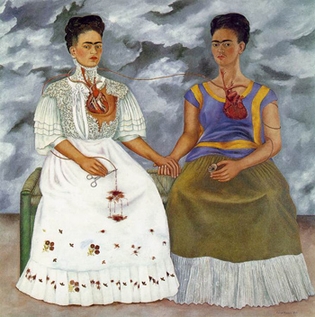
兩個弗里達 - 弗里達·卡羅的標誌性繪畫
六.健康問題及其對工作的影響
弗里達·卡羅 (Frida Kahlo) 的一生充滿了無情的身體疼痛和醫療並發症,但她將痛苦轉化為她強大的靈感源泉 繪畫。 1925 年發生的毀滅性公車事故不僅摧毀了她的身體,還為她一生與慢性疼痛、手術和情感痛苦作鬥爭奠定了基礎。儘管有這些障礙,卡羅還是將痛苦轉移到了自己身上 原創藝術品創作出深刻個人化且引起普遍共鳴的作品,探討身體創傷、身分認同和人類狀況等主題。痛苦成為她藝術身分的核心,透過她的作品,她重新定義了痛苦的界限 抽象藝術 和 哲學藝術,用她的畫布來表達她的生存鬥爭。
慢性疼痛和醫療問題
弗里達·卡羅 (Frida Kahlo) 的醫療困境並沒有隨著 1925 年公車事故中受傷的初步治療而結束。她一生中經歷了 30 多次手術,其中許多與她在車禍中遭受的脊椎損傷和骨折有關。長年的手術,加上長時間的臥床休息,讓她身體虛弱,持續疼痛。她的脊椎、骨盆和右腿受到的影響尤其嚴重,導致行動能力問題隨著時間的推移而惡化。卡羅也因受傷而出現了嚴重的併發症,包括慢性感染和消化問題。
隨著年齡的增長,卡羅的健康狀況進一步惡化。她患有 肾病,一種引起額外疼痛和疲勞的腎臟疾病。這種情況,再加上她的脊椎惡化,以及最終因壞疽而截肢,使她在生命的最後幾年幾乎完全臥床不起。然而,儘管她的身體日漸衰弱,她的精神和創造力卻沒有被削弱。她繼續在床上作畫,拒絕讓身體的限制扼殺她的藝術作品。
卡羅的健康問題不僅影響了她的工作內容,也影響了她對待工作的方式 繪畫。持續的疼痛迫使她在創作過程中採取更慢、更審慎的節奏,由於身體的限制,她經常短暫創作。她的床成了她的工作室,有一個特殊的畫架來適應她的不動。儘管受到這些限制,卡羅繼續繪畫的決心依然堅定,她的一些最著名的作品包括 「斷柱“ (1944)和 「沒有希望“ (1945),是在這段極度痛苦的時期創作的。
痛苦作為中心主題
身體和情緒上的痛苦成為弗里達卡羅許多最強作品的中心主題。她將痛苦轉化為視覺形式的能力使她創造了一個獨特的品牌 表現藝術 引起了全世界觀眾的共鳴。卡羅並沒有迴避她的痛苦,而是面對它,利用她 抽象藝術 描繪人類苦難中往往不可見和不言而喻的面向。
最著名的例子之一是 「斷柱“ (1944),其中卡羅用一根破碎的、搖搖欲墜的柱子代替了她的脊椎。金屬支架將她的身體固定在一起,她的皮膚被釘子刺穿,象徵著她脊椎受傷帶來的身體疼痛和伴隨她多年痛苦的情感痛苦。背景中貧瘠的風景反映了她的孤獨感。同時,她堅忍的表情表明她平靜地接受了自己的命運。這幅畫深刻地表現了卡羅如何改變她 創傷變成了關於人類脆弱性和力量的普遍敘事。
在 「沒有希望“ (1945),卡羅探討了疾病帶給她的情感損失。畫中的她躺在床上,身體被綁,巨大的漏斗將奇形怪狀、超現實的物體強行塞進她的嘴裡。這些圖像反映了她臥床不起並被迫忍受痛苦的醫療的許多時期之一的無助感。卡羅經常使用的鮮豔色彩緩和了場景的淒涼,這表明即使在她最黑暗的時刻,她的世界仍然存在著生命和能量。
卡羅對痛苦的描繪不僅限於她身體上的痛苦;她也探討了她動盪的關係所造成的情感痛苦,尤其是與丈夫迭戈·裡維拉的關係。工作原理就像 「兩個弗里達“ (1939)描繪了她身份的雙重性以及她與裡維拉分離的痛苦。在這幅畫中,卡羅用超現實主義元素描繪了她暴露在外、流血的心臟,以視覺隱喻她所遭受的情感創傷。這幅畫融合了個人和政治主題,弗里達代表了她的歐洲身份。同時,另一個象徵著她的墨西哥血統。這種二元性說明了她在身份、性別角色以及她在藝術界和整個社會中的地位方面的內心掙扎。
藝術作為一種治療形式
對弗里達·卡羅(Frida Kahlo)來說,藝術不僅僅是一種創造性的出路,更是一種在面對壓倒性的痛苦和身體限制時重新找回自己的身體和敘事的方式。透過反覆畫她 形像地說,她控制了別人對她的看法以及她對自己的看法。在一個經常將殘疾人邊緣化的社會中,卡羅用她的藝術挑戰關於美、力量和身份的傳統觀念。她的自畫像成為一種自我賦權的形式,讓她能夠斷言自己的存在並定義自己的術語。
一樣 Humberto Poidomani,卡羅的作品也深入探討了這個概念 哲學藝術,因為她的許多畫作都在探討有關生、死和人類狀況的存在主義問題。她經常使用象徵主義——例如融入骷髏、頭骨和其他與死亡相關的圖像——反映出她對死亡的關注。在 「自畫像與法裡爾博士的肖像“ (1951),卡羅描繪了自己拿著一個心形調色板,瘦弱的身體由輪椅支撐。這幅畫反映了她的身體虛弱和藝術力量,表明即使她的身體腐爛,她的創作精神仍然堅韌不拔。
藝術成為卡羅身體、情感和精神上的一種療癒方式。透過她 原創藝術品,她面對生活中的嚴酷現實,並將其轉化為美麗而有意義的東西。她的畫作讓她能夠處理自己的創傷,探索自己的身份,並向世界傳達她的經歷。這樣,卡羅的藝術超越了單純的自我表達,成為生存和個人賦權的工具。
弗里達作品中存在主義主題的探索
弗里達·卡羅的藝術經常被認為 哲學藝術 因為它探討了存在主義主題,例如身分、痛苦和存在的本質。在像這樣的作品中 「多蘿西‧黑爾的自殺“ (1939),卡羅不僅面對死亡的現實,而且沉思導致人們面對死亡的選擇和環境。這幅畫是克萊爾·布斯·盧斯(Clare Boothe Luce) 委託創作的,旨在紀念她的朋友多蘿西·黑爾(Dorothy Hale),它既是對黑爾自殺的致敬,也是令人毛骨悚然的描繪。卡羅對黑爾從紐約大樓墜落的詳細描述反映了她對人類心理和驅使人們走向自我毀滅的力量的興趣。
卡羅探索存在主義主題的另一個例子是 「希望之樹,保持堅強“ (1946),這幅畫並列了卡羅的兩張照片:一張躺在醫院病床上,暴露在外,脆弱不堪,另一張筆直地坐著,舉著寫著“希望之樹”的橫幅。“ 這幅畫反映了卡羅在絕望與堅韌之間的內心鬥爭,儘管她面臨巨大的挑戰,但她仍堅持希望。這部作品證明了她對人類意志的力量以及儘管難以克服的困難仍堅持不懈的能力的信念。
卡羅對生命、死亡和時間流逝的迷戀也體現在她作品中經常使用鏡子和倒影。這些主題顯示對自我感知的本質和所有個體內部的二元性進行更深刻的哲學探究。在她的許多自畫像中,卡羅將自己呈現為主體和觀察者,模糊了現實與想像、身體痛苦和情感痛苦之間的界線。
七.弗里達的政治活動和社會影響
弗里達·卡羅的藝術反映了她的掙扎,是她政治信念和社會評論的有力載體。深受 20 世紀墨西哥政治格局的影響,卡洛成為政治運動的積極參與者,利用她的作品來解決階級、種族、性別和身份問題。她對左翼政治的參與,特別是她在墨西哥共產黨的成員資格,塑造了她的世界觀,進而塑造了她的藝術。透過她的政治指控 社會評論藝術,卡羅成為受壓迫和邊緣化群體的代言人,使她成為早期女權主義偶像和討論的關鍵人物。 藝術與社會.
弗里達的政治參與
弗里達·卡羅對政治活動並不陌生。她在革命後的墨西哥長大,在一個政治與民族認同深深交織在一起的國家長大。墨西哥革命(1910-1920)深刻影響了該國的文化、藝術和社會結構,這種革命精神是卡羅一生吸收和傳承的。她真正開始參與政治是在 1920 年代末,當時她加入了墨西哥共產黨。這項決定將塑造她的個人和藝術生活。
卡羅對共產黨的承諾是出於她對社會正義和平等的渴望。她相信黨為工人階級和原住民的權利而奮鬥,這種信念也反映在她的藝術中。她與共產主義政治藝術家迭戈·裡維拉(Diego Rivera)的婚姻, 僅有的 加深了她對左翼政治的參與。兩人一起成為墨西哥知識界和政界的知名人物,在他們的家鄉 La Casa Azul 舉辦藝術家、作家和政治領導人的聚會。
卡羅創作了這一時期最明顯的政治畫作之一:“我的衣服掛在那裡“ (1933)。在這部作品中,她透過將財富和工業化的象徵與貧窮和苦難的形象並置來批評美國的消費主義和資本主義。這幅畫展示了奢華的美國城市景觀,其中有摩天大樓和教堂。同時,卡羅的傳統墨西哥服裝懸掛在前景中,在寒冷的工業化環境中似乎格格不入。透過這件作品,卡羅表達了她對她所目睹的物質主義和不平等的蔑視 在她的時代 在美國,清楚地表明了她的墨西哥身份與西方世界的資本主義過度之間的鮮明對比。
卡羅的政治參與不僅限於她的共產黨身分或對資本主義的批判;她也參與了政治活動。它延伸到了她的人際關係以及她的生活方式。她在家中接待了托洛斯基等流亡政治人物。她用她的藝術來突出墨西哥原住民和工人階級的鬥爭。透過融合個人和政治主題,卡羅的 藝術表現 成為倡導社會變革的有力工具。
與其他政治藝術家的聯繫
弗里達·卡羅並不是唯一一個將藝術用作政治活動的人。她是一個由左翼藝術家和知識分子組成的更大社區的一部分,他們相信藝術有能力影響社會變革。她的丈夫迭戈·裡維拉(Diego Rivera)也許是其中最著名的一位,以描繪墨西哥工人階級鬥爭的大型壁畫而聞名。裡維拉對卡羅政治觀點的影響不可小覷。透過他,她了解到藝術可以用作爭取社會正義的武器。
卡羅也與她那個時代的其他政治藝術家合作並影響他們。一位著名人物是俄羅斯革命家列昂·托洛茨基,在他被從蘇聯流放後,她和里維拉將他庇護在家中。托洛斯基和卡羅有過一段短暫的戀情,但更重要的是,他們對彼此的政治理想有著共同的欽佩。卡洛與托洛斯基的關係凸顯了她對全球範圍內左翼政治的承諾,而不僅僅是墨西哥境內。
卡羅的政治藝術和激進主義延伸到了她與其他女性藝術家的友誼和合作,其中許多女性藝術家與她一樣致力於挑戰社會規範和倡導婦女權利。透過與其他女性主義和左派藝術家的聯繫,卡羅成為一場尋求重新定義女性在藝術和社會中角色的運動中的關鍵人物。她的影響可以從蒂娜·莫多蒂(Tina Modotti)和雷梅迪奧斯·瓦羅(Remedios Varo)等藝術家的作品中看出,他們和卡羅一樣,利用自己的藝術來探索性別、階級和身分等主題。
透過這些合作,弗里達·卡羅幫助培育了一個由積極參與政治的藝術家組成的社區,他們相信政治的變革力量 社會評論藝術。他們共同挑戰現狀,並利用自己的創造力來引起人們對不平等和不公正問題的關注。卡羅作為政治藝術家的遺產激勵了一代又一代的藝術家和活動家,他們尋求利用自己的作品作為社會變革的平台。
作為女權主義偶像的遺產
弗里達·卡羅對女性主義藝術和思想的影響怎麼強調都不為過。在女性的聲音在藝術界經常被邊緣化的時代,卡羅用她的作品挑戰傳統的性別角色,並維護她作為女性、藝術家和政治活動家的自主權。她對女性身體的探索,無論是力量或脆弱,都是開創性的,她對女性氣質的描繪挑戰了當時西方藝術中常見的理想化、客觀化的形象。
卡羅的自畫像也許是她挑戰傳統性別角色的最佳例子。與許多將女性描繪成被動主體的男性藝術家不同,卡羅將自己呈現為主體和創造者,並以她的身體作為畫布來探索身份、性和權力的主題。在像這樣的作品中 “短髮自畫像“ (1940),卡羅剪掉了頭髮,穿上了男裝,拒絕了傳統的女性氣質。這幅畫有力地表達了性別流動性和對社會期望的拒絕。卡羅將自己呈現為男性和女性的形象,挑戰觀眾對性別的假設。
卡羅的 對性別和身分的探索也延伸到了她的個人生活。她是公開的雙性戀,並且與男性和女性都有關係,這違反了她那個時代的規範。她性別認同的這種流動性反映在她的藝術中,她經常將傳統的女性和男性意象融合在一起,創造出複雜、多面向的自我表現。
卡羅作為早期女權主義偶像的地位也體現在她對社會正義的承諾以及對邊緣化群體(特別是婦女和原住民)經驗的關注。她用自己的藝術來強調女性在身體和情感經驗上的掙扎。在像這樣的作品中 “亨利福特醫院“ (1932),卡羅描繪了她的流產。這種強烈的個人和痛苦的經驗很少在藝術中描繪。透過如此公開地展現自己的痛苦,卡羅打破了圍繞女性生殖健康的禁忌,並有力地闡述了女性聲音在藝術中的重要性。
卡羅的作品在今天的討論中引起了共鳴 身分政治, 女權主義和交叉性。她將個人經驗與政治評論結合的能力使她成為女性主義思想的關鍵人物,她的藝術也成為反抗壓迫的象徵。卡羅的 社會評論藝術 在當今世界仍然具有現實意義,性別、種族和階級問題仍然處於政治和社會討論的前沿。
卡羅的社會評論藝術與當今的相關性
弗里達卡羅的 社會評論藝術 是超前於時代的,而且在她去世後的幾年裡,它的相關性只增不減。在當今世界,關於 身分政治, 女權主義和交叉性比以往任何時候都更加重要,卡羅的作品有力地提醒人們藝術在挑戰社會規範和倡導變革方面的作用。
卡羅在作品中對性別、種族和階級的探索反映了當今藝術及其他領域的許多對話。她願意麵對複雜的主題,如身體疼痛、生殖健康和情感創傷,這引起了當代觀眾的共鳴,當代觀眾越來越要求藝術反映人類經驗的複雜性。透過這種方式,卡羅作為政治藝術家的遺產只會變得更加強大,因為她的作品激勵了新一代藝術家和活動家,他們尋求利用自己的藝術作為社會變革的工具。
卡羅對現代女性主義思想的影響可以從她的作品在今天的討論中受到的讚揚中看出 藝術與社會。她對身份、性別流動性和女性身體的探索激勵了無數藝術家突破藝術和社會可接受的界限。透過挑戰傳統規範並為邊緣化聲音創造空間,卡羅的作品已成為那些尋求利用藝術作為政治活動平台的人的燈塔。
此外,卡羅對墨西哥本土文化的關注以及對西方消費主義的批判在當今全球化的世界中具有了新的意義。隨著有關文化挪用、殖民主義和經濟不平等的討論變得更加突出,卡羅的作品為面對西方霸權時保持文化認同提供了寶貴的視角。她融合個人和政治主題的能力使她成為了永恆的人物 藝術表現.
總之,弗里達·卡羅的政治活動和 社會評論藝術 在藝術界和社會上留下了不可磨滅的印記。她致力於利用自己的藝術作為社會正義的平台,並願意直面複雜的主題,這使她成為抵抗和賦權的持久象徵。卡羅作為女權主義偶像和政治藝術家的遺產繼續激勵著尋求挑戰現狀並利用自己的作品倡導一個更公正和公平的世界的藝術家、活動家和思想家。
八.終身成就和認可
弗里達·卡羅的藝術遺產是深遠的影響、韌性和創新。儘管面臨嚴重的健康問題和社會限制,卡羅在她的一生中還是獲得了認可。然而,直到她死後,她的作品才獲得了今天所享有的巨大的國際讚譽。多年來,她的畫作已經超越了墨西哥的邊界,在最負盛名的地方找到了永久的家 美術館 全世界。她對現代和當代藝術的影響仍然巨大,她的作品繼續啟發新一代藝術家並重塑全球對話 藝術與文化.
榮譽和獎項
在她的一生中,弗里達·卡羅並沒有像她的丈夫迭戈·裡維拉(Diego Rivera)等一些同時代的男性那樣獲得那麼多的讚譽。然而,她能夠在藝術界為自己贏得一席之地,特別是在 20 世紀 30 年代和 1940 年代,當時她的作品開始在墨西哥以外的地區受到關注。
1938 年,她在紐約朱利安·利維畫廊 (Julien Levy Gallery) 舉辦了首次個展,她的作品受到了美國藝術界的高度讚譽。展覽包括她現在的一些標誌性畫作,例如 「水給了我什麼“ 和 “我的誕生。” 這標誌著她進入國際藝術界,並開始獲得認可,這種認可只會在未來幾年內不斷增長。超現實主義藝術家安德烈·布雷頓(André Breton)是展覽中最重要的參與者之一,他邀請卡洛在巴黎展出她的作品,進一步擴大了她的影響力。
1939年,卡羅的作品在巴黎國際超現實主義展覽會展出, 一個 主要的 里程碑 為她帶來了全球的認可。在這次展覽中,羅浮宮購買了她的畫作 「框架”,使卡洛成為第一位在博物館收藏中擁有畫作的墨西哥藝術家。儘管卡羅拒絕了超現實主義的標籤,但她參加巴黎展覽是一個關鍵時刻,有助於鞏固她在國際藝術界的地位。
雖然卡羅生前獲得的獎項和榮譽較少,但死後的認可卻是巨大的。自 1954 年去世以來,她的工作在全球範圍內受到廣泛讚譽 藝術展覽 和回顧展,承認她是女性主義藝術、超現實主義和墨西哥藝術的開拓者 文化藝術。如今,弗里達·卡羅被視為20世紀最有影響力的藝術家之一,她對當代藝術的影響力不斷增長。
弗里達的藝術在世界各地的博物館和藝術展覽中
弗里達卡羅 (Frida Kahlo) 的畫作曾出現在著名的 美術館 和今天的博物館。她的作品是重要機構永久收藏的一部分,確保她的遺產能夠持久並可供全球藝術愛好者使用。以下是可以體驗她的藝術的幾個關鍵地點:
- 弗里達卡羅博物館(La Casa Azul),墨西哥城:也許體驗 Kahlo 作品的最重要的地方是她的出生地 La Casa Azul。博物館收藏了她的許多物品、信件和精選的畫作。遊客可以漫步穿過弗里達居住和繪畫的房間,近距離了解她的生活。
- 紐約現代藝術博物館 (MoMA):MoMA 是卡羅多件標誌性作品的所在地,其中包括 “短髮自畫像“ (1940)。博物館定期在永久收藏和巡迴展覽中展示她的作品,突顯了她在現代藝術演變中的重要性。
- 倫敦泰特現代美術館:在倫敦,泰特現代美術館舉辦了 Frida Kahlo 的回顧展,引起了全球的關注。她將個人痛苦與普遍主題聯繫起來的能力繼續吸引著觀眾。
- 巴黎羅浮宮:如前所述,羅浮宮成為第一個收藏她作品的大型博物館。 「框架“ (1938)這幅畫將她的墨西哥傳統與超現實主義元素融為一體,至今仍是博物館永久收藏的一部分。
- 密西根州底特律藝術學院:卡羅最重要的作品之一, 《與猴子的自畫像》“ (1938),在這裡展出,讓參觀者深入了解定義她後來大部分作品的複雜象徵意義。
除了這些永久收藏之外,弗里達·卡羅的作品仍然是巡迴展覽的焦點。舊金山現代藝術博物館、華盛頓特區國家女性藝術博物館和費城藝術博物館都曾舉辦過大型回顧展。這些展覽將卡羅的作品介紹給了新的觀眾,並在保持她的遺產的遺產方面發揮了重要作用。
她對現當代藝術家的影響
弗里達·卡羅對當代藝術的影響是深遠而多方面的。她極其個人化和毫無歉意的繪畫方式影響了無數藝術家,他們尋求利用藝術作為探索身份、創傷和復原力的手段。卡羅的 藝術靈感 跨越各種媒介,從繪畫和雕塑到表演藝術和攝影。她的遺產在以下領域具有影響力:
- 女性主義藝術:卡羅通常被認為是女性主義藝術的先驅之一。她對女性身體的無畏探索,包括其痛苦和不完美,挑戰了男性主導的藝術世界對女性的理想化描繪。朱迪·芝加哥和辛蒂·謝爾曼等當代女權主義藝術家從卡羅的作品中汲取靈感,尤其是她利用自畫像來控制自己的形象。卡羅願意直面流產、不忠和心理健康等複雜話題,至今仍引起女性主義藝術家的共鳴。
- 生態藝術:卡羅對大自然的熱愛以及動植物的頻繁融入也影響了當代 環境藝術。 Ana Mendieta 和 Gabriela Mistral 等藝術家從卡羅對大自然的象徵性運用中汲取靈感,探索人類與環境的相互連結。在像這樣的作品中 「根源“ (1943),卡羅將自己描繪成自然世界的一部分,用樹根來比喻她與地球重新連結的願望。在當今關於環保主義和永續發展的討論中,人與自然連結的主題變得越來越重要。
- 超現實主義與象徵主義:雖然卡羅拒絕了超現實主義的標籤,但她對超現實主義和象徵藝術的影響是不可否認的。薩爾瓦多·達利和雷梅迪奧斯·瓦羅等藝術家欽佩卡洛將幻想與現實融為一體的能力,在她的畫作中創造出夢幻般的品質。她的作品激發了超現實主義和象徵主義藝術家的靈感,他們透過奇幻的意象探索無意識的思維和人類經驗的複雜性。
卡羅的影響也體現在 最近的 藝術趨勢 強調 個人敘事和政治活動。在身份政治和交叉性成為藝術和文化話語前沿的時代,卡羅的作品提醒人們藝術解決社會問題的力量。當藝術家們努力解決這些問題時,她對種族、性別和階級等主題的關注在今天仍然具有現實意義。
聚焦在弗里達遺產的現代展覽
近幾十年來,人們對弗里達·卡羅的生活和作品重新產生了興趣,並舉辦了許多展覽,致力於在歷史和當代藝術的背景下探索她的遺產。這些展覽慶祝了她對現代藝術的貢獻,並強調了她在今天的討論中的相關性 藝術與文化.
- 弗里達卡羅:打扮自己“ (維多利亞和阿爾伯特博物館,倫敦,2018 年):這次開創性的展覽展示了卡羅的許多個人物品,包括她的衣服、珠寶、假腿以及她的畫作。展覽讓人們近距離了解卡羅是如何 身份影響了她的工作以及她如何透過藝術和自我展示塑造自己的形象。
- 弗里達卡羅:外表可能具有欺騙性“ (布魯克林博物館,紐約,2019):這次展覽探討了卡羅的藝術、政治和時尚之間的交叉點。它包括標誌性的繪畫、個人文物和照片,展示了卡羅如何利用她的外表作為一種政治和文化表達。這次展覽將卡羅的女性、藝術家和政治活動家的身份聯繫起來。
- 「弗里達卡羅與流行藝術“ (丹佛藝術博物館,2020 年):本次展覽重點關注卡洛與墨西哥民間藝術的關係以及她如何將流行藝術傳統融入她的作品中。它強調了卡羅如何模糊美術和流行藝術之間的界限,將原住民和民間傳統提升為高雅藝術。
這些現代展覽有助於鞏固卡羅作為 20 世紀最重要和最具影響力的藝術家之一的地位。他們還將她的作品介紹給新一代的藝術愛好者,確保她的遺產在未來幾年繼續激發和影響。
九.結論:弗里達卡對現代藝術的持久影響
弗里達·卡羅對現代藝術的影響是無與倫比的。她將個人痛苦、身分和人類情感的複雜性轉化為生動的、具有像徵意義的傑作的能力,在世界上留下了不可磨滅的印記。 藝術表現。幾十年來,她的作品超越了國界和學科,影響了畫家、雕塑家、作家、電影製片人和文化理論家。卡羅是一位先驅者,他重新定義了自畫像的界限,將個人與政治融為一體,並創造了一個空間,在這個空間中,痛苦、激情和韌性被視為人類經驗不可或缺的方面。
卡羅的影響 現代藝術 從她的作品如何彌合文化、情感和政治分歧就可以看出。她對自己身體疼痛的毫無歉意的描繪,加上她對代表墨西哥傳統的承諾,使她成為一位全球人物,其作品超越了她的時代。卡羅以她的個人身份和苦難為平台來評論更廣泛的主題,例如階級、種族、性別以及傳統與現代之間的緊張關係。透過這樣做,她幫助塑造了話語 國際藝術 透過擴大藝術所能解決的範圍,個人痛苦不僅是自我反思的主題,也是社會和政治評論的主題。
卡羅的作品繼續引起當代觀眾的共鳴。她對性別流動性、認同政治和本土文化的探索在今天仍然具有驚人的現實意義。在這個圍繞種族、女性主義和交叉性的對話成為藝術世界和社會話語核心的時代,卡羅的作品是一塊重要的試金石。她拒絕遵守傳統的性別角色,對自己的身體進行毫無歉意的描繪,並擁抱她的墨西哥根源,使她成為女權主義和後殖民藝術運動中的重要人物。
弗里達·卡羅 (Frida Kahlo) 在塑造 21 世紀藝術表達方面的作用
在21世紀, 藝術表現 已經採取了新的形式,但卡羅的影響力在各種媒體上仍然顯而易見。她的自畫像和身份認同激發了藝術家更開放地探索他們的個人和文化敘事。卡羅將象徵主義、超現實主義和 文化藝術 影響了無數尋求將個人與政治融合的當代藝術家。她處理痛苦、堅韌和自我表現等普遍主題的能力催生了一些藝術家,他們利用自己的作品挑戰社會規範並探索複雜的個人敘事。
如今,她的影響力已超越畫布,滲透到時尚、攝影、電影和表演藝術中。她的臉飾有她標誌性的一字眉和特瓦納連身裙,已成為個性和反抗的標誌性象徵。她現在是藝術中個人故事講述力量的象徵,特別是在解決流產、慢性疼痛和心理健康等複雜和禁忌話題方面。
卡羅的影響也體現在藝術家現在的創作方式上 藝術多樣性。 她將墨西哥本土文化與現代主義影響進行了開創性的融合,為更包容地理解什麼是「高雅藝術」鋪平了道路。“ 如今,來自不同文化背景的藝術家可以利用自己的遺產而不必擔心被邊緣化,這在一定程度上要歸功於卡羅在作品中擁抱文化多樣性的開創性方法。
卡羅對藝術收藏家和全球藝術家的持續影響
弗里達卡羅 (Frida Kahlo) 作品的需求 藝術收藏家 近年來才有所增加,反映了她不朽的遺產。她的畫作往往具有強烈的個人色彩,已成為全球藝術市場上最受歡迎的作品之一。工作原理就像 「兩個弗里達“ 和 《戴荊棘項鍊與蜂鳥的自畫像》“ 被認為是 20 世紀藝術的標誌性代表。它們在拍賣會上拍出高價,反映出卡羅在藝術領域的認可度不斷提高,以及她對幾代藝術家和收藏家的持久影響。
卡羅的 工作引起共鳴 藝術收藏家 因為它挖掘了痛苦、愛和身份的普遍經歷,同時提供了由她的墨西哥傳統塑造的獨特視角。她的畫作是她靈魂的窗戶,揭示了個人與普遍之間的深刻聯繫。對於收藏家來說,擁有一件卡羅的作品不僅是對藝術史的投資,更是與超越文化和時間界限的韌性和真實性遺產的聯繫。
在全球範圍內,卡羅對藝術家的影響是深遠的。從在作品中擁抱個人和政治敘事的當代畫家,到利用自己的身體作為自我表達畫布的女性主義藝術家,卡羅的遺產無所不在。她使用 社會評論藝術 今天仍然具有現實意義,藝術家繼續解決不平等、身份政治和交叉性問題。卡羅以原始的誠實面對複雜主題的能力激勵藝術家突破藝術交流的界限,確保她在現代和當代藝術經典中的地位。
結論:弗里達·卡羅 (Frida Kahlo) 是堅韌、創造力和藝術多樣性的象徵
弗里達·卡羅 (Frida Kahlo) 的遺產植根於她的繪畫天賦、非凡的韌性、創造力和對藝術的承諾。 藝術多樣性。她克服了巨大的身體痛苦、情緒痛苦和社會限制,創作了一些現代歷史上最具影響力和持久的藝術作品。卡羅的故事是關於逆境中堅持不懈的故事,她將個人創傷轉化為藝術的能力激勵了全世界數百萬人。
作為韌性的象徵,卡羅代表人類精神的勝利。她拒絕被痛苦定義,而是將其視為力量和創造力的來源。她的自畫像充滿了象徵意義和情感,講述了一個女人不畏懼直面自己的弱點的故事。透過這種方式,卡羅已經成為藝術家和任何面臨困難並找到方法將其轉化為有意義的事物的人的力量象徵。
卡羅的創造力是無止境的。她不斷突破藝術的界限,將傳統的墨西哥符號與現代主義技術融合在一起,創造出一系列極具個人魅力但具有普遍吸引力的作品。她願意探索通常被視為禁忌的主題,例如疼痛、流產和心理健康,這對人們產生了持久的影響。 藝術多樣性,鼓勵後代藝術家擁抱自己獨特的故事和文化背景。
總而言之,弗里達·卡羅 (Frida Kahlo) 對 現代藝術, 國際藝術, 和 藝術表現 無論如何強調都不為過。她是一位開拓者,重新定義了藝術家在社會中的角色,利用她的作品挑戰社會規範並倡導邊緣化的聲音。她的遺產是堅韌、創造力和創造力的象徵 藝術多樣性 確保她的作品將繼續激勵和影響子孫後代的藝術家、收藏家和藝術愛好者。
這一結論總結了弗里達·卡羅對現代和國際藝術的深遠影響,強調了她在塑造藝術表達方面的作用以及對藝術家和藝術家的持續影響。 藝術收藏家。關鍵字「藝術多樣性,” 「藝術表達,“ 和“藝術收藏家“ 已順利融入正文。如果您需要任何進一步的調整或添加,請告訴我!
X. 其他資源和參考資料
網路和實體畫廊為希望探索弗里達·卡羅的生活、工作以及對現代和當代藝術的持續影響的讀者提供了大量資源。以下列表連結 線上美術館, 數位藝術畫廊以及收藏她標誌性作品的博物館,提供了更多了解她的藝術遺產的機會,甚至 在线购买艺术品.
線上美術館和數位資源
在數位時代,人們對弗里達·卡羅 (Frida Kahlo) 作品的訪問範圍不斷擴大,讓世界各地的觀眾無需前往實體場所即可體驗她的藝術。下列 線上美術館 和 數位藝術畫廊 提供與卡羅的生活和藝術相關的豐富資訊、收藏和互動體驗:
- Google 藝術與文化 – 弗里達卡羅 (Frida Kahlo) 收藏:Google 的藝術與文化平台提供卡羅作品的全面數位展覽,包括她最著名的畫作的高分辨率圖像、La Casa Azul(藍屋)的 360 度遊覽以及有關她生活的詳細文章。
- 連結:Google 藝術與文化 – Frida Kahlo
- 現代藝術博物館線上收藏:現代藝術博物館的線上畫廊展示了弗里達·卡羅的幾幅畫作,包括 “短髮自畫像“ (1940)。該網站提供了每件作品的詳細信息,包括其歷史背景和藝術意義。
- 連結:MoMA Frida Kahlo 收藏
- 弗里達卡羅:全集:該網站是弗里達·卡羅 (Frida Kahlo) 的繪畫、素描和草圖的數位檔案。參觀者可以瀏覽她的作品、閱讀傳記資訊並了解她最著名的畫作。
弗里達卡羅 (Frida Kahlo) 的畫作收藏於世界上一些最負盛名的博物館中。對於那些希望親眼目睹她的作品的人來說,以下機構設有永久收藏品並經常舉辦專門針對她的藝術的展覽:
- 弗里達卡羅博物館(La Casa Azul),墨西哥城:這個博物館位於卡羅時的家中,是了解她的生活和工作的最重要的地方之一。遊客可以看到她的個人文物、信件和幾幅原畫,這對於對她的藝術之旅感興趣的人來說是一個重要的一站。
- 關聯: 弗里達卡羅博物館 – 拉卡薩阿祖爾
- 紐約現代藝術博物館 (MoMA):MoMA 擁有數個 弗里達卡羅的 最知名的作品。博物館定期在展覽中展出她的畫作,探討她在塑造現代藝術中的作用。
- 關聯: 現代藝術博物館 – 弗里達卡羅
- 倫敦泰特現代美術館:泰特現代美術館曾多次展出卡羅的作品回顧展,她對超現實主義和現代主義的影響是博物館規劃中常見的主題。
- 關聯: 泰特現代美術館-弗里達‧卡羅
- 巴黎羅浮宮:羅浮宮藏有弗里達卡羅的一幅畫作, 「框架“ (1938),這是墨西哥藝術家第一幅被博物館永久收藏的作品。
- 連結:羅浮宮 – 框架
- 密西根州底特律藝術學院:底特律藝術學院特色 卡羅的 “與猴子的自畫像“ (1938)和迭戈·裡維拉(Diego Rivera)的壁畫,全面展示了這對夫婦對墨西哥和美國藝術的影響。
- 關聯: 底特律藝術學院——弗里達·卡羅
有關弗里達·卡羅的其他資源
- 關聯: 底特律藝術學院——弗里達·卡羅
對於希望深入了解卡羅的生活和遺產的讀者,有幾本書、紀錄片和播客提供了關於她的作品和影響力的深刻見解:
- “弗里達:弗里達卡羅傳記“ 作者:海登·埃雷拉(Hayden Herrera):這本傳記是卡羅生活和藝術最全面的傳記之一,詳細介紹了她的個人奮鬥、人際關係和創作過程。
- 連結:弗里達:弗里達卡羅傳記
- “芙烈達“ (2002 年電影):這部獲得奧斯卡獎的傳記片由薩爾瑪海耶克主演,戲劇化地講述了卡洛的一生,重點關注她的人際關係、健康問題以及作為藝術家的崛起。
- 關聯: 弗里達在 IMDb 上的資料
